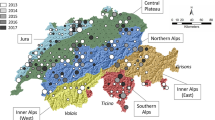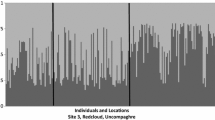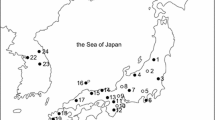Abstract
The White Mountain arctic butterfly [WMA; Oeneis melissa semidea (Say)] is endemic to the alpine zone of Mts. Washington and Jefferson, New Hampshire, USA, and because of its small and declining population size, it is considered threatened. White Mountain arctic adults occur only within four alpine meadows, and it has been suggested that dispersal, and hence gene flow, may be restricted among these meadow subpopulations. Furthermore, although the WMA likely is biennial (i.e., requires 2 years for development) like all other species of Oeneis, adults emerge annually. Thus the WMA population may be further structured into two allochronic cohorts, reproductively isolated by their asynchronous adult emergence in either even- or odd-numbered years. We assessed the spatial (among meadows) and temporal (between even- and odd-year cohorts) genetic structure and diversity of the WMA using mtDNA and AFLP markers generated from non-lethally sampled wing and leg tissue. We found no evidence for restricted gene flow among meadows. AFLPs indicated weak differentiation between alternate year cohorts; however, it remains unclear whether this resulted from allochronic reproductive isolation or genetic drift. Despite the WMA’s small population size and isolation, levels of AFLP genetic diversity were generally high. Rather than focusing on factors related to population connectivity and adult dispersal, our results suggest that management efforts for the WMA should instead focus explicitly on factors affecting recruitment and mortality.



Similar content being viewed by others
References
Agnarsson I, Avilés L, Maddison WP (2012) Loss of genetic variability in social spiders: genetic and phylogenetic consequences of population subdivision and inbreeding. J Evol Biol 26:27–37
Anthony GS (1970) Field work on the population structure of Oeneis melissa semidea (Satyridae) from the Presidential Range, New Hampshire. J Res Lepid 7:133–148
Aspinwall N (1974) Genetic analysis of North American populations of the pink salmon, Oncorhynchus gorbuscha, possible evidence for the neutral mutation-random drift hypothesis. Evolution 28:295–305
Bergerot B, Merckx T, Van Dyck H, Baguette M (2012) Habitat fragmentation impacts mobility in a common and widespread woodland butterfly: do sexes respond differently? BMC Ecol 12:5. doi:10.1186/1472-6785-1112-1185
Boncristiani H, Li J, Evans JD, Pettis J, Chen Y (2011) Scientific note on PCR inhibitors in the compound eyes of honey bees, Apis mellifera. Apidologie 42:457–460
Brattström O, Akesson S, Bensch S (2010) AFLP reveals cryptic population structure in migratory European red admirals (Vanessa atalanta). Ecol Entomol 35:248–252
Britten HB, Brussard PF, Murphy DD, Ehrlich PR (1995) A test for isolation-by-distance in central Rocky Mountain and Great Basin populations of Edith’s checkerspot butterfly (Euphydryas editha). J Hered 86:204–210
Brock J, Kaufman K (2003) Kaufman field guide to butterflies of North America. Houghton Mifflin Company, New York
Bromilow SM, Sperling FAH (2011) Phylogeographic signal variation in mitochondrial DNA among geographically isolated grassland butterflies. J Biogeogr 38:299–310
Brussard PF, Ehrlich PR, Singer MC (1974) Adult movements and population structure in Euphydryas editha. Evolution 28:408–415
Charman TG, Sears J, Green RE, Bourke AFG (2010) Conservation genetics, foraging distance and nest density of the scarce great yellow bumblebee (Bombus distinguendus). Mol Ecol 19:2661–2674
Clarke A, Meudt H (2005) Amplified fragment length polymorphism (AFLP) for multilocus genomic fingerprinting. Alan Wilson Centre for Ecology and Evolution, Massey University, New Zealand. http://clarkeresearch.org/aflp_2012-01-26/aflp.html. Accessed 6 Feb 2015
Collier N, Gardner AM, McMahon CR, Benkendorff K, Mackay DA (2010) Contemporary habitat loss reduces genetic diversity in an ecologically specialized butterfly. J Biogeogr 7:1277–1287
Crawford LA (2013) Genetic and morphological variation of butterflies in relict habitats. Dissertation, Western University
Crawford LA, Desjardins S, Keyghobadi N (2011) Fine-scale genetic structure of an endangered population of the Mormon metalmark butterfly (Apodemia mormo) revealed using AFLPs. Conserv Genet 12:991–1001
Crawford LA, Koscinski D, Keyghobadi N (2012) A call for more transparent reporting of error rates: the quality of AFLP data in ecological and evolutionary research. Mol Ecol 21:5911–5917
Danks HV (1992) Long life cycles in insects. Can Entomol 124:167–187
Darvill B, O’Connor S, Lye GC, Waters J, Lepais O, Goulson D (2010) Cryptic differences in dispersal lead to differential sensitivity to habitat fragmentation in two bumblebee species. Mol Ecol 19:53–63
Dieker P, Drees C, Schmitt T, Assmann T (2013) Low genetic diversity of a high mountain burnet moth species in the Pyrenees. Conserv Genet 14:231–236
Douwes P (1980) Periodical appearance of species of the butterfly genera Oeneis and Erebia in Fennoscandia (Lepidoptera: Satyridae). Entomol Gen 6:151–157
Douwes P, Stille B (1988) Selective versus stochastic processes in the genetic differentiation of populations of the butterfly Erebia embla (Thnbg) (Lepidoptera, Satyridae). Hereditas 109:37–43
Earl DA, vonHoldt BM (2012) STRUCTURE HARVESTER: a website and program for visualizing STRUCTURE output and implementing the Evanno method. Conserv Genet Resources 4:359–361
Eckhart L, Bach J, Ban J, Tschachler E (2000) Melanin binds reversibly to themostable DNA polymerase and inhibits its activity. Biochem Biophys Res Commun 271:726–730
Evanno G, Regnaut S, Goudet J (2005) Detecting the number of clusters of individuals using the software STRUCTURE: a simulation study. Mol Ecol 14:2611–2620
Excoffier L, Lischer HEL (2010) Arlequin suite ver 3.5: A new series of programs to perform population genetics analyses under Linux and Windows. Mol Ecol Res 10:564–567
Frankham R (1996) Relationship of genetic variation to population size in wildlife. Conserv Biol 10:1500–1508
Frankham R (2010) Challenges and opportunities of genetic approaches to biological conservation. Biol Conserv 143:1919–1927
Frankham R, Ballou JD, Briscoe DA (2010) Introduction to conservation genetics. Cambridge University Press, New York
Franklin MT, Ritland CE, Myers JH (2010) Spatial and temporal changes in genetic structure of greenhouse and field populations of cabbage looper, Trichoplusia ni. Mol Ecol 19:1122–1133
Futuyma DJ (2009) Evolution, 2nd edn. Sinauer Associates Inc, Sunderland
Gompert Z, Nice CC, Fordyce JA, Forister ML, Shapiro AM (2006) Identifying units for conservation using molecular systematics: the cautionary tale of the Karner blue butterfly. Mol Ecol 15:1759–1768
Gradish AE (2015) Population structure, phylogeography, and conservation of two North American arctic (Oeneis spp.) butterflies. Dissertation, University of Guelph
Gradish AE, Otis GW (2015) Notes on the demography, life history, and behavior of the White Mountain arctic butterfly (Oeneis melissa semidea). J Lep Soc 69:108–113
Habel JC, Zachos FE, Finger A, Meyer M, Louy D, Assmann T, Schmitt T (2009) Unprecedented long-term genetic monomorphism in an endangered relict butterfly species. Conserv Genet 10:1659–1665
Habel JC, Assmann T, Schmitt T, Avise JC (2010a) Relict species: from past to future. In: Habel JC, Assmann T (eds) Relict species: phylogeography and conservation biology. Springer-Verlag, Berlin, pp 1–5
Habel JC, Augenstein B, Meyer M, Nève G, Rödder D, Assmann T (2010b) Population genetics and ecological niche modelling reveal high fragmentation and potential future extinction of the endangered relict butterfly Lycaena helle. In: Habel JC, Assmann T (eds) Relict species: phylogeography and conservation biology. Springer, Berlin, pp 417–439
Hamm CA, Aggarwal D, Landis DA (2010) Evaluating the impact of non-lethal DNA sampling on two butterflies, Vanessa cardui and Satyrodes eurydice. J Insect Conserv 14:11–18
Harper GL, Maclean N, Goulson D (2003) Microsatellite markers to assess the influence of population size, isolation and demographic change on the genetic structure of the UK butterfly Polyommatus bellargus. Mol Ecol 12:3349–3357
Heliövaara K, Väisänen R (1984) The biogeographical mystery of the alternate-year populations of Aradus cinnamomeus (Heteroptera, Aradidae). J Biogeogr 11:491–499
Heliövaara K, Väisänen R, Hantula J, Lokki J, Saura A (1988) Genetic differentiation in sympatric but temporally isolated pine bark bugs. Hereditas 109:29–36
Heliövaara K, Väisänen R, Simon C (1994) Evolutionary ecology of periodical insects. Trends Ecol Evol 9:475–480
Jakobsson M, Rosenberg NA (2007) CLUMPP: a cluster matching and permutation program for dealing with label switching and multimodality in analysis of population structure. Bioinformatics 23:1801–1806
Kankare M, Várkonyi G, Saccheri I (2002) Genetic differentiation between alternate-year cohorts of Xestia tecta (Lepidoptera, Noctuidae) in Finnish Lapland. Hereditas 136:169–176
Keyghobadi N (2007) The genetic implications of habitat fragmentation for animals. Can J Zool 85:1049–1064
Keyghobadi N, Roland J, Strobeck C (2005) Genetic differentation and gene flow among populations of the alpine butterfly, Parnassius smintheus, vary with landscape connectivity. Mol Ecol 14:1897–1909
Keyghobadi N, Unger KP, Weintraub JD, Fonseca DM (2006) Remnant populations of the regal fritillary (Speyeria idalia) in Pennsylvania: local genetic structure in a high gene flow species. Conserv Genet 7:309–313
Keyghobadi N, Crawford LA, Maxwell SA (2009) Successful analysis of AFLPs from non-lethally sampled wing tissues in butterflies. Conserv Genet 10:2021–2024
Keyghobadi N, Koscinski D, Weintraub JD, Fonseca DM (2013) Historical specimens reveal past relationships and current conservation status of populations in a declining species: the regal fritillary butterfly. Insect Conserv Divers 6:234–242
Koch PB, Kaufmann N (1995) Pattern specific melanin synthesis and DOPA decarboxylase activity in a butterfly wing of Precis coenia Huber. Insect Biochem Mol Biol 25:73–82
Kodandaramaiah U, Konvicka M, Tammaru T, Wahlberg N, Gotthard K (2012) Phylogeography of the threatened butterfly, the woodland brown Lopinga achine (Nymphalidae: Satyrinae): implications for conservation. J Insect Conserv 16:305–313
Konvička M, Benes J, Schmitt T (2010) Ecological limits vis-à-vis changing climate: relic Erebia butterflies in insular Sedeten mountains. In: Habel JC, Assmann T (eds) Relict species: phylogeography and conservation biology. Springer, Berlin, pp 341–355
Krumm JT, Hunt TE, Skoda SR, Hein GL, Lee DJ, Clark PL, Foster JE (2008) Genetic variability of the European corn borer, Ostrinia nubilalis, suggests gene flow between populations in the Mid-western United States. J Insect Sci 8:1–12
Kuras T, Benes J, Fric A, Konvicka M (2003) Dispersal patterns of endemic alpine butterflies with constrasting population structures: Erebia epiphron and E. sudetica. Popul Ecol 45:115–123
Layberry RA, Hall PW, Lafontaine JD (2001) The butterflies of Canada. University of Toronto Press, Toronto
Leidner AK, Haddad NM (2010) Natural, not urban, barriers define population structure for a coastal endemic butterfly. Conserv Genet 11:2311–2320
Lloyd M, White JA (1976) Sympatry of periodical cicada broods and the hypothetical four-year acceleration. Evolution 30:786–801
Lushai G, Fjellsted W, Marcovitch O, Aagaard K, Sherratt TN, Allen JA, Maclean N (2000) Application of molecular techniques to non-lethal tissue samples of endangered butterfly populations (Parnassius apollo L.) in Norway for conservation management. Biol Conserv 94:43–50
Lynch M, Milligan BG (1994) Analysis of population genetic structure with RAPD markers. Mol Ecol 3:91–99
Mantel NA (1967) The detection of disease clustering and a generalized regression approach. Cancer Res 27:209–220
Marschalek DA, Jesu JA, Berres ME (2013) Impact of non-lethal genetic sampling on the survival, longevity and behvaiour of the Hermes copper (Lycaena hermes) butterfly. Insect Conserv Divers 6:658–662
McFarland K (2003) Conservation assessment of two endemic butterflies (White Mountain arctic, Oeneis melissa semidea, and White Mountain fritillary, Boloria titania montinus) in the Presidential Range alpine zone, White Mountains, New Hampshire. Vermont Center for Ecostudies, Norwich, Vermont. http://vtecostudies.org/wildlife/insects/butterflies/white-mountain-arctic. Accessed 2 Feb 2015
Monroe EM, Lynch C, Soluk DA, Britten HB (2010) Nonlethal tissue sampling techniques and microsatellite markers used for first report of genetic diversity in two populations of the endangered Somatochlora hineana (Odonata: Corduliidae). Annu Entomol Soc Am 103:1012–1017
New Hampshire Fish and Game Department (2006) Species profile: White Mountain arctic (Oeneis melissa semidea). In: New Hampshire Wildlife Action Plan, New Hampshire Fish and Game Department, pp A-74–A-78. http://www.wildlife.state.nh.us/Wildlife/wildlife_plan.htm. Accessed 2 Feb 2015
Opel KL, Chung D, McCord BR (2010) A study of PCR inhibition mechanisms using real time PCR. J Forensic Sci 55:25–33
Opler PA, Krizek GO (1984) Butterflies east of the Great Plains. The Johns Hopkins University Press, Baltimore
Peakall R, Smouse PE (2006) GENALEX 6: genetic analysis in Excel. Population genetic software for teaching and research. Mol Ecol Notes 6:288–295
Polic D, Fiedler K, Nell C, Grill A (2014) Mobility of ringlet butterflies in a high-elevation alpine grassland: effects of habitat barriers, resources and age. J Insect Conserv 18:1153–1161
Pritchard JK, Stephens M, Donnelly P (2000) Inference of population structure using multilocus genotype data. Genetics 155:945–959
Rose OC, Brookes MI, Mallet JLB (1994) A quick and simple nonlethal method for extracting DNA from butterfly wings. Mol Ecol 3:275
Rosenberg NA (2004) DISTRUCT: a program for the graphical display of population structure. Mol Ecol Notes 4:137–138
Saccheri I, Kuussaari M, Kankare M, Vikman P, Fortelius W, Hanski I (1998) Inbreeding and extinction in a butterfly metapopulation. Nature 392:491–494
Schmitt T, Cizek O, Konvička M (2005) Genetics of a butterfly relocation: large, small and introduced populations of the mountain endemic Erebia epiphron silesiana. Biol Conserv 123:11–18
Schmitt T, Muster C, Schönswetter P (2010) Are disjunct alpine and arctic-alpine animal and plant species in the western Palearctic really “relicts of a cold past”? In: Habel JC, Assmann T (eds) Relict species: phylogeography and conservation biology. Springer, Berlin, pp 239–252
Schroeder H, Degen B (2008) Spatial genetic structure in populations of the green oak leaf roller, Tortrix viridana L. (Lepidoptera, Tortricidae). Eur J For Res 127:447–453
Scott JA (1986) The butterflies of North America: a natural history and field guide. Stanford University Press, Stanford
Scudder SH (1901) A courageous butterfly, Oeneis semidea. Psyche 9:194–197
Sekar S, Karanth P (2013) Flying between sky islands: the effect of naturally fragmented habitat on butterfly population structure. PLoS One. doi:10.1371/journal.pone.0071573
Shawkey MD, Morehouse NI, Vukusic P (2009) A protean palette: colour materials and mixing in birds and butterflies. J R Soc Interface 6:S221–S231
Sigaard P, Pertoldi C, Madsen AB, Søgaard B, Loeschcke V (2008) Patterns of genetic variation in isolated Danish populations of the endangered butterfly Euphydryas aurinia. Biol J Linn Soc 95:677–687
Slack NG, Bell AW (2006) Appalachian mountain club field guide to the New England summits. Appalachian Mountain Club Books, Boston
Spielman D, Brook BW, Frankham R (2004) Most species are not driven to extinction before genetic factors impact them. Proc Natl Acad Sci 101:15261–15264
Takami Y, Koshio C, Ishii MU, Fujii H, Hidaka T, Shimizu IM (2004) Genetic diversity and structure of urban populations of Pieris butterflies assessed using amplified fragment length polymorphism. Mol Ecol 13:245–258
Tao J, Chen M, Zong SX, Luo YQ (2012) Genetic structure in the seabuckthorn carpenter moth (Holcoerus hippophaecolus) in China: the role of outbreak events, geographical and host factors. PLoS One 7:e30544. doi:10.31371/journal.pone.0030544
Tauber CA, Tauber MJ (1981) Insect seasonal cycles: genetics and evolution. Annu Rev Ecol Syst 12:281–308
Thomas JA (2005) Monitoring the change in the abundance and distribution of insects using butterflies and other indicator groups. Philos T Roy Soc B 360:339–357
Timm AE, Geertsema H, Warnich L (2006) Gene flow among Cydia pomonella (Lepidoptera: Tortricidae) geographic and host populations in South Africa. J Econ Entomol 99:341–348
Timm AE, Geertsema H, Warnich L (2008) Population genetic structure of Grapholita molesta (Lepidoptera: Tortricidae) in South Africa. Annu Entomol Soc Am 101:197–203
Todisco V, Gratton P, Cesaroni D, Sbordoni V (2010) Phylogeography of Parnassius apollo: hints on taxonomy and conservation of a vulnerable glacial butterfly invader. Biol J Linn Soc 101:169–183
Väisänen R, Heliövaara K (1990) Morphological variation in Aradus cinnamomeus (Heteroptera, Aradidae): discrimination between parapatric alternate-year populations. Annu Zool Fennici 27:29–47
Vandewoestijne S, Baguette M (2004) Genetic population structure of the vulnerable bog fritillary butterfly. Hereditas 141:199–206
Vekemans X (2002) AFLP-SURV version 1.0. Distributed by the author. Laboratoire de Génétique et Ecologie Végétale, Université Libre de Bruxelles, Belgium
Vila M, Auger-Rozenburg MA, Goussard F, Lopez-Vaamonde C (2009) Effect of non-lethal sampling on life-history traits of the protected moth Graellsia isabelae (Lepidoptera: Saturniidae). Ecol Entomol 34:356–362
Vos P, Hogers R, Bleeker M, Reijans M, van de Lee T, Hornes M, Frijters A, Pot J, Peleman J, Kuiper M (1995) AFLP: a new technique for DNA fingerprinting. Nucleic Acids Res 23:4407–4414
Whitlock R, Hipperson H, Mannarelli M, Butlin K, Burke T (2008) An objective, rapid and reproducible method for scoring AFLP peak-height data that minimizes genotyping error. Mol Ecol Res 4:725–735
Williams KS, Simon C (1995) The ecology, behavior, and evolution of periodical cicadas. Annu Rev Entomol 40:269–295
Williams BL, Brawn JD, Paige KN (2003) Landscape scale genetic effects of habitat fragmentation on a high gene flow species: Speyeria idalia (Nymphalidae). Mol Ecol 12:11–20
Zhivotovsky LA (1999) Estimating population structure in diploids with multilocus dominant DNA markers. Mol Ecol 8:907–913
Acknowledgments
We gratefully acknowledge Thanushi Eagalle, Amy Reinert, and Andrew Frewin for field assistance; Lindsay Crawford for advice and assistance on AFLP analyses; Kent McFarland for advice on working with the WMA and navigating the Mt. Washington alpine zone; Howie Weymss for allowing us access to the Mt. Washington Auto Road; Chris Costello and the US Forest Service for providing accommodations during our field work; and Felix Sperling and Steve Marshall for editorial comments on an earlier version of this manuscript. This study was funded by a Natural Science and Engineering Research Council of Canada Industrial Post Graduate Scholarship in partnership with the Cambridge Butterfly Conservatory awarded to A. E. Gradish.
Author information
Authors and Affiliations
Corresponding author
Electronic supplementary material
Below is the link to the electronic supplementary material.
Rights and permissions
About this article
Cite this article
Gradish, A.E., Keyghobadi, N. & Otis, G.W. Population genetic structure and genetic diversity of the threatened White Mountain arctic butterfly (Oeneis melissa semidea). Conserv Genet 16, 1253–1264 (2015). https://doi.org/10.1007/s10592-015-0736-y
Received:
Accepted:
Published:
Issue Date:
DOI: https://doi.org/10.1007/s10592-015-0736-y




